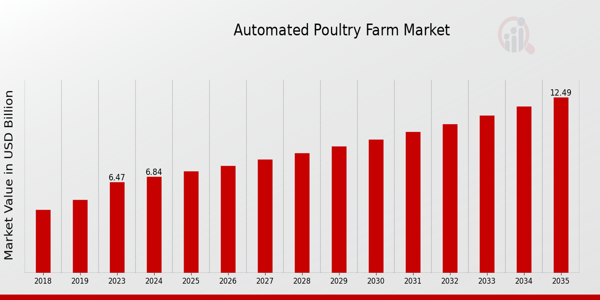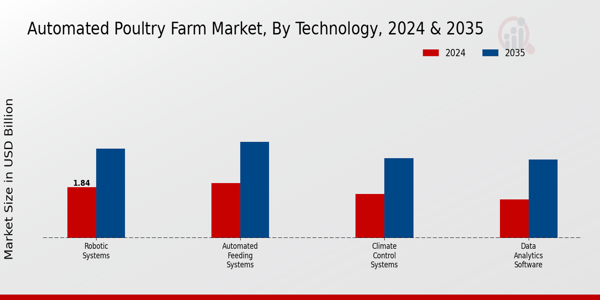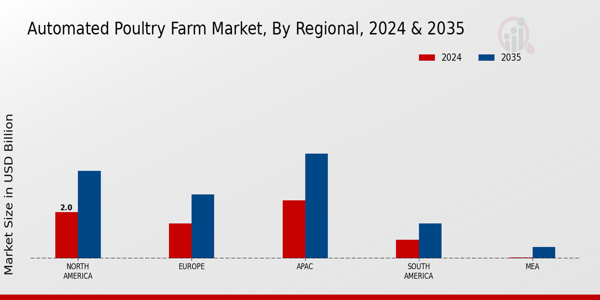Global Automated Poultry Farm Market Overview
Automated Poultry Farm Market Size was estimated at 6.47 (USD Billion) in 2023. The Automated Poultry Farm Industry is expected to grow from 6.84(USD Billion) in 2024 to 12.5 (USD Billion) by 2035. The Automated Poultry Farm Market CAGR (growth rate) is expected to be around 5.63% during the forecast period (2025 - 2035).

Source Primary Research, Secondary Research, MRFR Database and Analyst Review
Key Automated Poultry Farm Market Trends Highlighted
The Automated Poultry Farm Market is experiencing significant growth driven by increasing demand for protein-rich food, along with rising consumer awareness about animal welfare and food safety. Advancements in technology, such as artificial intelligence and the Internet of Things, are facilitating more efficient operations, helping farmers monitor and control the farming environment more effectively. The push for sustainability and reduced labor costs further drives the adoption of automation in poultry farming. Opportunities exist in developing solutions tailored for emerging markets where traditional practices dominate. Increased investments in research and development can lead to innovative products that enhance productivity and improve animal health.As more farmers seek to modernize their operations, there is a growing demand for smart farming technologies that can integrate seamlessly with existing systems. The focus on vertical farming and urban agriculture offers additional avenues for market expansion, catering to regions facing space constraints. Recent trends indicate a surge in the adoption of automated feeding and watering systems. These innovations are helping to minimize human error and optimize resource use, aligning with efforts toward sustainable farming practices. There is an increasing emphasis on data analytics to monitor flock health and productivity, enabling farmers to make informed decisions.The rise of precision farming practices is also shaping the market, with farmers leveraging technology to enhance efficiency and reduce waste. As the poultry industry embraces these advancements, the landscape of poultry farming is likely to transform significantly, paving the way for a more efficient and sustainable future.
Automated Poultry Farm Market Drivers
Rising Demand for Poultry Products
The increasing population and changing dietary preferences are driving the demand for poultry products like chicken and eggs. The Automated Poultry Farm Market Industry is witnessing a significant shift as consumers are looking for more sustainable and high-quality protein sources. Automation in poultry farming allows for more efficient production processes that boost productivity and ensure optimal growth conditions for birds, leading to higher yields.With the expected valuation of the market by 2024 and substantial growth anticipated thereafter, producers are compelled to adopt automated systems to meet the growing consumer demand while simultaneously addressing concerns related to food safety and hygiene. Moreover, industry players are focusing on enhancing their production capabilities and automation presents a viable solution. By incorporating automated feeding, watering, and monitoring systems, farmers can significantly reduce labor costs while improving the overall efficiency of their farms.This shift not only addresses economic factors but also environmental considerations, as automated systems contribute to more sustainable farming practices. The integration of smart technologies and IoT in poultry farming is further streamlining operations and ensuring better management of resources.
Consequently, the Automated Poultry Farm Market is poised for exponential growth considering these mounting factors. Thus, it is important for stakeholders to be aware of new developments in the technology and market so as to maximize new opportunities arising.
Technological Advancements in Farming
Advancements in technology are revolutionizing the Automated Poultry Farm Market Industry by enhancing operational efficiency and productivity. Smart farming technologies, including automation, artificial intelligence, and IoT, are enabling poultry farmers to monitor their farms remotely, manage resources effectively and optimize production processes. These innovations not only streamline farm operations but also lead to improved animal welfare and biosecurity measures.
Increased Focus on Sustainable Practices
With growing awareness about environmental issues and sustainability, the Automated Poultry Farm Market Industry is experiencing a surge in the adoption of eco-friendly practices. Automated systems help reduce waste, conserve water, and minimize the carbon footprint, aligning with goals for sustainability and responsible agriculture while meeting consumer preferences for ethically produced food.
Automated Poultry Farm Market Segment Insights
Automated Poultry Farm Market Technology Insights
The Technology segment of the Automated Poultry Farm Market has shown significant growth, reflecting advancements in agricultural practices and the increasing need for efficient poultry farming. In 2024, the market is expected to be valued at 6.84 USD Billion, highlighting the rising investment in automation technologies to optimize operations and enhance productivity. Among various segments, Robotic Systems is projected to be valued at 1.84 USD Billion in 2024, showcasing its importance in streamlining processes such as egg collection, vaccination, and feeding, thereby allowing farmers to reduce labor costs while improving efficiency.The Automated Feeding Systems segment stands out with a valuation of 2.0 USD Billion, addressing the critical need for accurate and timely feeding to maximize poultry growth potential. This technology ensures the nutritional needs of the birds are met consistently, which is a fundamental aspect of modern poultry management. Climate Control Systems, valued at 1.6 USD Billion, play a significant role in maintaining optimal environmental conditions for poultry, directly impacting health, productivity, and egg production quality. Effective climate control not only enhances bird welfare but also provides a competitive edge in meeting food demand.Meanwhile, the Data Analytics Software segment, with a market valuation of 1.4 USD Billion in 2024, enables farmers to leverage data-driven insights to make informed decisions, optimize operations, and enhance overall productivity. By analyzing data on feed efficiency, growth rates, and environmental conditions, poultry producers can identify trends and implement strategies that boost profitability. Overall, each component within the Technology segment addresses distinct challenges faced by poultry farmers, ultimately contributing to a more sustainable and profitable farming ecosystem.The projected valuations for 2035, with Robotic Systems at 3.25 USD Billion, Automated Feeding Systems at 3.5 USD Billion, Climate Control Systems at 2.9 USD Billion, and Data Analytics Software at 2.85 USD Billion, further indicate an upward trend in comprehensive automation solutions that will likely foster innovation and efficiency in the Automated Poultry Farm Market. As market dynamics evolve, the importance of these technologies in enhancing productivity and sustainability is expected to escalate, fostering stronger growth in the industry.

Source Primary Research, Secondary Research, MRFR Database and Analyst Review
Automated Poultry Farm Market Product Type Insights
The market segmentation around Product Type emphasizes the significant roles played by Layer Poultry, Broiler Poultry and Breeder Poultry. Layer Poultry is crucial as it primarily focuses on egg production, making it a fundamental component of poultry farming. Broiler Poultry, known for meat production, dominates the sector due to rising protein consumption. Breeder Poultry, responsible for producing breeding stock, supports the entire poultry supply chain, ensuring quality and sustainability in production.The continuous growth driven by increasing consumer demand for poultry products, technological advancements, and the need for efficient farming practices highlights the importance of these segments. Nevertheless, challenges such as biosecurity concerns and fluctuating feed prices can impact market dynamics. The Automated Poultry Farm Market statistics suggest a steady path toward modernization, providing opportunities for innovation and improvement in poultry production processes.
Automated Poultry Farm Market Farm Size Insights
The Automated Poultry Farm Market is on a steady growth trajectory, particularly within the Farm Size segment, which plays a critical role in shaping market dynamics. The segmentation of the market by farm size reveals a diverse landscape dominated by various scales of operation. The small-scale farms are pivotal in driving innovation, attracting new entrants, and enhancing productivity due to their adaptability and lower investment requirements. Meanwhile, medium-scale operations provide a balance of efficiency and automation that caters to both large consumer demand and sustainability practices.Large-scale farms dominate in terms of production volume and cost efficiency, allowing for streamlined operations and maximized output. This division in farm size not only showcases varying operational capabilities but also reflects the broader trends in the Automated Poultry Farm Market industry, with each segment addressing distinct market demands and challenges. As the industry evolves, these categorizations underscore the significance of tailored technological solutions and resource management strategies across the spectrum of farm sizes, enhancing overall market growth prospects.
Automated Poultry Farm Market End Use Insights
The End Use segment of this market reflects a diverse landscape, categorized into various applications such as Commercial Farming, Backyard Farming and Integrated Farming. Commercial Farming holds a major share of the market due to the increasing demand for poultry products and the need for efficient production methods. This segment not only emphasizes higher productivity but also integrates advanced technologies in operations, thus enhancing overall yield.Backyard Farming has gained traction among individuals looking for sustainable living options and fresh produce, reflecting a growing trend toward self-sufficiency and organic farming practices. On the other hand, Integrated Farming represents a holistic approach to agricultural practices, where poultry is efficiently combined with other farming activities, promoting resource optimization. The shift toward automation in these diverse applications is driven by factors such as technological advancements, increased awareness of food safety, and the need for sustainable farming methods.The Automated Poultry Farm Market data indicates that as the industry expands, so does the opportunity for innovation and investment across these end-use segments, positioning the market for sustainable growth.
Automated Poultry Farm Market Regional Insights
North America accounts for a significant share, valued at 2.0 USD Billion in 2024, and is expected to grow to 3.75 USD Billion by 2035, reflecting its dominance in poultry technology adoption. Europe follows with a valuation of 1.5 USD Billion in 2024, enhancing its market presence to 2.75 USD Billion in 2035. The APAC region is notably strong, valued at 2.5 USD Billion in 2024, driven by increasing poultry meat consumption and investment in automation technologies to optimize production.South America, although smaller, holds a steady market value of 0.8 USD Billion in 2024, growing to 1.5 USD Billion by 2035. The MEA region shows modest growth potential with a starting value of 0.04 USD Billion in 2024 and reaching 0.5 USD Billion by 2035, indicating an early stage in market development. These insights reflect the Automated Poultry Farm Market segmentation, where regions like North America and APAC significantly dominate due to established infrastructures and increasing demand for efficient poultry farming solutions.

Source Primary Research, Secondary Research, MRFR Database and Analyst Review
Automated Poultry Farm Market Key Players and Competitive Insights
The Automated Poultry Farm Market is currently experiencing significant advancements and transformations that are reshaping competitive dynamics. The increasing demand for poultry products, coupled with the need for higher productivity and efficiency in farming practices, is driving the adoption of automation technologies. As a result, numerous players have emerged, each vying for market share while innovating to cater to the evolving needs of poultry farmers. Competitors in this market not only focus on enhancing livestock health and productivity but also emphasize sustainability through eco-friendly farming practices. Technological advancements such as precision farming, data analytics, and IoT systems are enhancing the capabilities of automated poultry farming, leading to competitive advantages among market leaders.Big Dutchman is a considerable contributor to the Automated Poultry Farm Market, boasting an extensive presence with a well-established reputation for quality and reliability. The company excels in providing a comprehensive range of solutions, from feeding systems to climate control technologies, tailored specifically for poultry operations. This versatility enables Big Dutchman to cater to different-sized enterprises, making their offerings appealing to both small and large-scale producers. Furthermore, Big Dutchman's strong distribution network ensures that their advanced technologies are accessible in various regions, enhancing their customer reach. The company's commitment to innovation allows it to consistently introduce new products that optimize operational efficiency, thus reinforcing its leadership position in the automated poultry farming sector.Ziggity Systems, another prominent player in the Automated Poultry Farm Market, brings unique strengths that enhance its competitive positioning. Known for its cutting-edge drinking systems designed for poultry farming, Ziggity Systems ensures that water access is efficient and tailored to the different growth stages of poultry. This focus on vital resources underscores their commitment to maximizing animal welfare and productivity. Additionally, Ziggity Systems places a strong emphasis on customer service and support, facilitating the seamless integration of their systems into various farming operations. The emphasis on sustainability and resource efficiency resonates well with environmentally conscious consumers, allowing Ziggity Systems to strengthen its market presence. Their innovative approach continually meets the demands of modern poultry farming, contributing significantly to their growth within the market landscape.
Key Companies in the Automated Poultry Farm Market Include
- Big Dutchman
- Ziggity Systems
- Valco Melton
- Skov
- Lely
- InnovaFeed
- API Heat Transfer
- Rotem
- ChoreTime
- Hubbard
- GSI
- Aviagen
- Vencomatic
- Feed Strategy
Automated Poultry Farm Market Industry Developments
Recent developments in the Automated Poultry Farm Market reflect ongoing innovation and growth driven by key players like Big Dutchman, Ziggity System, and GSI. The demand for automation solutions is rising as farmers seek efficiency and enhanced production capabilities. Notable advancements include Skov's latest climate control systems, designed to optimize poultry environments, and Lely's integration of AI technology to improve productivity. In the area of mergers and acquisitions, there have been significant movements, with companies like Valco Melton and API Heat Transfer strengthening their market positions through strategic partnerships aimed at expanding their product lines and geographic presence.
Companies such as Aviagen and Hubbard continue to invest in research and development to enhance breeding programs, ultimately impacting growth and valuation in the sector. The increasing value of these companies underscores a robust market trajectory as automated solutions become essential in meeting consumer demands for sustainable and high-quality poultry products. The innovations and consolidations within this landscape suggest a dynamic interplay between technology advancements and market expansion efforts among the leading organizations.
Automated Poultry Farm Market Segmentation Insights
- Automated Poultry Farm Market Technology Outlook
- Robotic Systems
- Automated Feeding Systems
- Climate Control Systems
- Data Analytics Software
- Automated Poultry Farm Market Product Type Outlook
- Layer Poultry
- Broiler Poultry
- Breeder Poultry
- Automated Poultry Farm Market Farm Size Outlook
- Small Scale
- Medium Scale
- Large Scale
- Automated Poultry Farm Market End Use Outlook
- Commercial Farming
- Backyard Farming
- Integrated Farming
| Report Attribute/Metric |
Details |
| Market Size 2023 |
6.47(USD Billion) |
| Market Size 2024 |
6.84(USD Billion) |
| Market Size 2035 |
12.5(USD Billion) |
| Compound Annual Growth Rate (CAGR) |
5.63% (2025 - 2035) |
| Report Coverage |
Revenue Forecast, Competitive Landscape, Growth Factors, and Trends |
| Base Year |
2024 |
| Market Forecast Period |
2025 - 2035 |
| Historical Data |
2019 - 2024 |
| Market Forecast Units |
USD Billion |
| Key Companies Profiled |
Big Dutchman, Ziggity Systems, Valco Melton, Skov, Lely, InnovaFeed, API Heat Transfer, Rotem, ChoreTime, Hubbard, GSI, Aviagen, Vencomatic, Feed Strategy |
| Segments Covered |
Technology, Product Type, Farm Size, End Use, Regional |
| Key Market Opportunities |
1. Smart farming technology integration, 2. Rising meat demand, 3. Sustainable farming practices adoption, 4. Enhanced biosecurity systems, 5. Cost reduction through automation |
| Key Market Dynamics |
1. Increasing demand for automation, 2. Rise in meat consumption, 3. Cost reduction in poultry farming, 4. Enhancements in poultry health, 5. Environmental sustainability practices |
| Countries Covered |
North America, Europe, APAC, South America, MEA |
Frequently Asked Questions (FAQ) :
The Automated Poultry Farm Market was expected to be valued at 6.84 USD Billion in 2024.
By 2035, the market size for the Automated Poultry Farm Market is projected to be valued at 12.5 USD Billion.
The Automated Poultry Farm Market is expected to grow at a CAGR of 5.63% from 2025 to 2035.
In 2024, North America was expected to have a market value of 2.0 USD Billion, followed by APAC at 2.5 USD Billion.
The market for Automated Feeding Systems is expected to be valued at 2.0 USD Billion in 2024.
Major players in this market include Big Dutchman, Ziggity Systems, Valco Melton and Skov, among others.
The market size for Robotic Systems is projected to increase to 3.25 USD Billion by 2035.
Challenges could include regulatory hurdles and the initial investment costs associated with automation technology.
The APAC region is expected to show significant growth, with a market value increasing from 2.5 USD Billion in 2024 to 4.5 USD Billion in 2035.
The expected market value for Climate Control Systems is projected to reach 2.9 USD Billion by 2035.

















